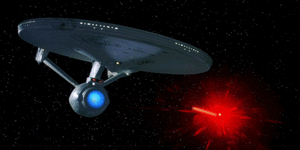Torpedo
A torpedo is a type of self-propelled, self-guided projectile weapon used by many spacefaring powers. They can be distinguished from missiles because torpedoes are generally launched with a system that applies external force to the projectile to accelerate it dramatically as its fired, while missiles accelerate entirely under their own power, but this is primarily a technical distinction. Many torpedo types can also be fired without a launcher, in which case they act like missiles. They can also often be dropped unpowered like bombs.
Common Torpedo Types
Photon Torpedo
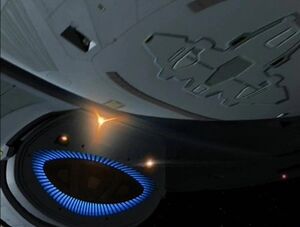
Photon torpedoes are the most common type of torpedo weapon encountered across the Milky Way due to the fact that their method of operation is derived from the matter/antimatter reactors that power the majority of warp capable starships in the galaxy. All photon torpedoes contain matter and antimatter held in suspension. When contact is achieved with the target, the suspension fields deactivate to allow the reactants to combine, which results in an explosion as the matter and antimatter annihilate one another and create pure energy. The sophistication of these weapons varies, as does their yield.
Starfleet has used photon torpedoes since the early 23rd Century. These cylindrical weapons are standardized across the fleet and can be fired by nearly any Starfleet vessel. Stored in magazines near their launchers, photon torpedoes are only filled with reactants as they are being loaded for firing. Starfleet's photon torpedoes are classified by their model (designated by mark), which describes its guidance system, propulsion, and casing, as well as their class, which describes the warhead's explosive yield. As of 2401, Starfleet's standard photon torpedo is the Mark XXX torpedo casing fitted with a Class-6 warhead, which has a yield of 25 isotons. Warheads up to class 10 can be produced, but quantum torpedoes or tricobalt devices are generally used in situations where high explosive yields are required, as there are diminishing returns.
Photon torpedoes are also used by the Klingons, Cardassians, and Ferengi.
Quantum Torpedo
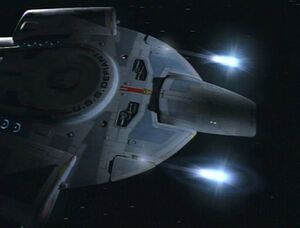
Quantum torpedoes are advanced matter/antimatter weapons that use a zero-point chamber to focus their matter/antimatter explosion to increase its yield exponentially. Like photon torpedoes, they contain two different reactants which are kept in suspension until detonation. Upon detonation, the suspension is released and the resulting explosion is channeled into a super-durable sphere to create an zero-point reaction. Compared to a photon torpedo with the same amount of reactants, the yield of a quantum torpedo will have an explosive yield that is proportionally squared. For instance, the reactants for a class-6 25 isoton photon torpedo would create a 625 isoton explosion when used in a quantum torpedo.
Starfleet first developed quantum torpedoes in the 2370s during the Dominion War, and have generally been reserved for tactically-oriented starships, given their extremely high destructive potential. They have a similar form-factor to photon torpedoes, allowing them to be fired from most launchers, but the casings themselves require advanced construction techniques and materials that cannot easily be replicated. As of 2401, Starfleet has gone through ten iterations of the quantum torpedo, and the current model in service is the Mark X quantum torpedo, which fitted standard with a class-6 warhead. At its current maximum yield, a quantum torpedo with a class ten warhead would have an explosive yield of 2,500 isotons.
Quantum torpedoes are also used by the Klingons, Dominion, and Cardassians.
Plasma Torpedo
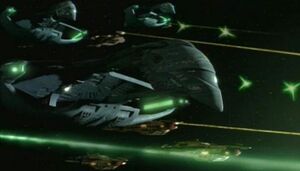
Plasma torpedoes store massive amounts of energized gas (i.e. plasma) either in physical storage systems very similar to other standard torpedo types or suspended in an electromagnetic field. Physical plasma torpedoes have similar range and penetration to other torpedo types, while field-suspended plasma torpedoes are only effective at close range, as they begin to dissipate quickly. Plasma torpedos have significantly lower infrastructure requirements, as they are fed from a starship's electro-plasma power grid and so can be located anywhere on the ship, not relying on matter and antimatter supplies to be piped in, but they also do not have the added safety interlock inherent in photon and quantum torpedoes provided by two separate reactants that are inert until combined.
Plasma torpedoes are used primarily by the Romulans, Borg, Orions, and Nausicaans.
Torpedo Launch Systems
As mentioned in the introductions, torpedoes are primarily launched with systems that accelerate them with external forces upon firing. Most torpedo launchers operate either with the expulsion of compressed gas, electromagnetic energy, or a combination of these forces. Once launched, the torpedo's internal guidance and propulsion systems take over and make any necessary corrections to ensure they make contact with the target.
Single-Fire Launchers
Sometimes just called a "torpedo tube," single-fire launchers are the most common type of torpedo launcher. In these systems, torpedoes are armed and loaded either directly into the launch tube or into a staging chamber. Once in the tube, compressed gas or electromagnetic forces propel the torpedo at a high rate of speed out into space. As the name suggests, they fire one torpedo at a time, but systems with staging chambers can have multiple torpedoes on hot standby to be loaded into the chamber in rapid succession. For instance, the class-4 torpedo launchers on the Constitution II were cable of launching one torpedo every two seconds, with up to four warheads held just behind the launch tube. While burst-fire launchers must be ever-wider to handle larger salvos, single-fire launchers' successive firing rate can be increased either with longer loading tracks, vertical staging systems, or wider staging chambers, which makes them more adaptable to the internal dynamics of various ships.
Starfleet single-fire launchers are designated in types based on the number of rounds they can hold for immediate firing, such as the Type-4 system mentioned above. Vessels employing single-fire rather than burst-fire torpedo launchers often have these systems mounted in pairs, which allows them to lay down a near-constant stream of fire by alternating between launchers. Type-6 launchers are standard on Starfleet vessels built after 2350. There's no theoretical limit to the number of torpedoes that could be held ready to fire, but higher type numbers require larger amounts of space, space which is filled with armed torpedoes, which means that accidental explosions can be significantly harder to contain.
Burst-Fire Launchers
Burst-fire launchers are torpedo launch systems that can fire multiple torpedoes simultaneously. This can be accomplished either through having multiple launch tubes collected together into a composite launcher or through using extremely large torpedo tubes which can contain more than one torpedo together in a cluster held together by an electromagnetic field, which dissipates several seconds after launch to allow the torpedoes to separate and reach their targets.
Starfleet first developed burst-fire torpedo launchers in the 2350s for deployment aboard the Galaxy-class explorer, with initial prototypes coming into service aboard the Cheyenne and Springfield. Like with single-fire launchers, they are designated based on the number of warheads they can launch at any one time, as well as the number of salvos they can hold in reserve. The launchers aboard Galaxy-class starships are Type-10, as they can fire a single salvo of 10 torpedoes, but must reload before firing again. The launchers aboard the newer Odyssey-class starships are Type-15B, meaning that they can fire salvos of 15 torpedoes and hold two salvos immediately in reserve. As with single-fire launchers, increasing launch capacity requires lots of space within a vessel. The largest launchers currently in service are the Type-20C launchers fitted to Guardian and Probert-class stations, which can launch salvos of 20, with three salvos held in reserve. It is worth noting that a vessel or station could quickly deplete its torpedo supplies using these launchers, and these numbers reflect their absolute maximum capabilities. Starfleet tactical doctrine calls for the minimal use of force required to disable a threat, meaning that most situations will call for single-fire or small salvo uses of these launchers.
Torpedo Turrets
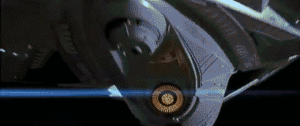
Torpedo turrets are launch systems where the firing angle of the weapon can be changed independently of the ship's heading. Typically engineered for rapid fire, they can either be burst or single fire systems. The advantage they offer is a much wider firing arc than other torpedo launchers, but their equipment is complex and bulky.
Starfleet only employs torpedo turrets on a small number of starship classes, notably the Sovereign-class exploratory cruiser and the Obena-class emissary. These launchers are capable of firing photon or quantum torpedoes at a rate of two per second, using a single-fire launcher with a vertical loading track that feeds torpedoes from the magazine above the turret into the launch chamber below. They are technically classified as Type-10 single-fire launchers, but their loading speed is so high that they can theoretically empty their entire magazine without pausing. Maintaining the systems necessary to accomplish this while also allowing the turret to track is difficult, which has limited their widespread deployment across the fleet.
Torpedoes In-Play
| Warhead Class | Photon Yield | Quantum Yield |
|---|---|---|
| 1 | 2.5 isotons | 6.25 isotons |
| 2 | 5.0 isotons | 25.00 isotons |
| 3 | 10.0 isotons | 100.00 isotons |
| 4 | 15.0 isotons | 225.00 isotons |
| 5 | 20.0 isotons | 400.00 isotons |
| 6 | 25.0 isotons | 625.00 isotons |
| 7 | 30.0 isotons | 900.00 isotons |
| 8 | 35.0 isotons | 1225.00 isotons |
| 9 | 40.0 isotons | 1600.00 isotons |
| 10 | 45.0 isotons | 2025.00 isotons |
